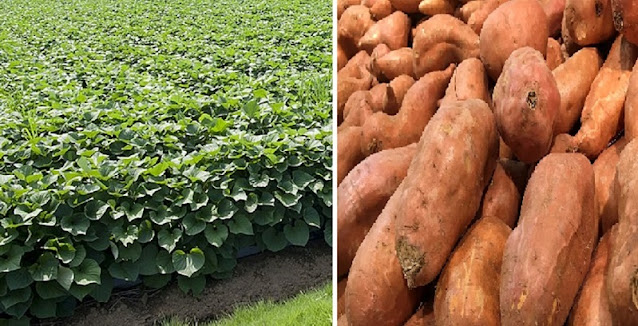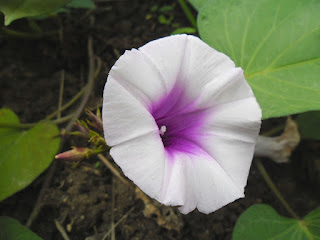Cultivation of Sweet Potato ( Sakharkanda) ; A complete Information Guide
Cultivation of Sweet Potato ( Sakharkanda) ; A complete Information Guide
Sweet Potato (Ipomea batatas Lam) Belongs family Convolvulaceae poularly known as “sakharkanda” in India. Sweet Potato is a very important tuber crop in tropical and sub-tropical countries like Africa, China, U.S.A., and India. In India, sweet potato is mainly un in Bihar, U.P., West Bengal, Madras, Maharashtra, and Punjab. It is majorly used for human consumption and for the manufacture of starch and alcohol. It is used as a popular vegetable in some parts of India. The vines of sweet potato are excellent fodder for cattle. It is a subsidiary food crop and an efficient caloric supplier.
 |
| Flowering Field of Sweet Potato |
Nutritive Value of Sweet Potato;
The nutritive value of sweet potato in 100 gms of the edible portion is given below ;
|
Nutrient |
Value |
Nutrient |
Value |
|
Moisture |
68.5 g |
Manisum |
12 mg |
|
Protein |
1.8 g |
Chlorine |
85 mg |
|
Fat |
0.7 g |
Vitamin A |
7700 IU |
|
Fibre |
1.0 g |
Vitamin B group |
0.46 |
|
Carbohydrate |
27.8 g |
Vitamin C |
22 mg |
|
Calcium |
30 g |
Vitamin E |
40 mg |
|
Phosphorus |
49 g |
Pantothenic |
0.93 mg |
|
Iron |
0.7 g |
Nicotinic acid |
0.46 mg |
|
Sulphur |
15 g |
Vitamin C |
22 mg |
|
Potassium |
530g |
|
|
its food and vitamin value can be compared with that of rice. Sweet potato is good for stepping food production and it contains starch which various from 19-32 %
Climatic Conditions required for Sweet Potato Cultivation;
Sweet potato is a tropical and subtropical crop and requires a long warm growing season. Plenty of sunshine and moderate rainfall (75-150 cms.) with Warm nights and days for four months are best suited for it. It is a drought-resistant vegetable. But it does not stand frost.
Soil and its preparation for Sweet Potato Cultivation;
Sweet potato can be grown on a wide range of soils. But light soils are invariably regarded as suitable for sweet potato. Sweet potato prefers a moderately acid Soil . The optimum PH range is 5.8 to 6.7.
The land should be well prepared and of good tilth for sowing sweet potato, 4-5 ploughings should be given to prepare a good tilth. After ploughing, planking is essential to make soil pulverized and leveled. Heptaf-5-D @ 810 kg per acre or Aldrin or Chlorodane 5 %t @ 10-15 kg per acre should be applied with the last preparatory tillage to check the Soil pests.
Important Varieties of Sweet Potato
Sweet potato varieties are divided into two groups according to tuber color, viz. (i) Red skin and (ii) White skin. The followings are the important ;
|
Variety |
Characteristics |
|
Punjab Sweet Potato-21 |
The vines of this variety are medium long in length.. It contains deep red color tubers having white flesh which is 20cm long and 4cm wide. The variety gets mature within 145 days. The average weight of tuber is 75g. The tuber contains 35% of dry matter and 81mg/g of starch. It gives an average yield of 75 qtl/acre. |
|
Varsha |
It is recommended to grown in Maharashtra. It is suitable to grown in rainy season. It gives an average yield of 62.5 qtl/acre. |
|
Konkan Ashwini |
This variety is developed to be cultivated in Maharashtra. It is short duration crop and gives high yield. |
|
Sree Arun |
Sree Arun: It is an early maturing variety having pink color skin and cream color flesh. The variety is developed by Central Tuber Crop Research Institute (CTCRI), Sreekariyam. It gives an average yield of 83-116 qtl/acre. |
|
Sree Kanaka |
The variety is developed by Central Tuber Crop Research Institute (CTCRI), Sreekariyam. It has cream color skin tuber which has dark orange color inner flesh. It gives an average yield of 41-62.5 qtl/acre. |
|
Sree Varun |
The variety is developed by Central Tuber Crop Research Institute (CTCRI), Sreekariyam. It contains cream color skin of the tuber. It is an early maturing variety which gets mature within 90-100 days. It gives an average yield of 80-110 qtl/acre. |
H- 268, Pusa Safed, Pusa red, Pusa sunahari, NO- 4004, S- 30, Klamath and recent one Skarkand – 5. The period of maturity of all the major varities are ranges between 90- 140 days. In general it is ready for harvesting in 120 days.
Planting time of Sweet Potato Crop;
The Planting time varies considerably in different parts of the country. viz.
North India – March or June-July
Sweet potato can be propagated by tubers slips or vine cuttings. Propagation by vine cuttings is a very common practice. The cuttings are grown in the nursery from the old vines or from slips produced on the tubers planted in the nursery bed. The vine cuttings are planted either on ridges for monsoon crops or in flatbed in low rainfall areas.
Seed Rate of Sweet Potato ;
About 10-20 thousand cuttings are required for planting an acre of land. 160-200 kg of tubers give enough slips to plant an acre. For one acre of planting, a nursery of 1/10th acre is required for producing slips.
Manuring in Sweet Potato Crop ;
Sweet potato responds well to manuring. A sweet potato crop yielding 15 tones per hectare removed from the soil about 70 kg of N20 kg of Phosphoric acid, and 110 kg of potassium per hectare
Intercultural operation in Sweet Potato Crop ;
Hoeing and weeding are done with a view to control the weeds and to make the soil loose and friable. This operation should continue till the vines spread and cover the field. The application of amiben (Chloromben) @ 3 kg a.i. per hectare after transplanting and Eptam (EPTC) @ 1.5 and 3.0 kg a.i. per hectare incorporated before transplanting gave fair to good weed control and caused little or no injury to sweet potato crops
The crop planted on ridges is earthed up when the crop is about two and a half months old.
Irrigation Requirement in Sweet Potato Crop ;
The water requirement of this crop is about 30-acre inch. Sweet potato is generally cultivated as a rainfed crop in Eastern India. But in absence of rainfall, the crop should be irrigated frequently to get a good crop.
Insect and Pest Manegement in Sweet Potato
a) Insects Manement in Sweet Potao ;
1. Sweet Potato Weevil
Sweet Potato Weevil is the most serious pest of this crop. A red and blue ant-like Weevil that makes holes in the stem and tubers. The pale yellow grub of this pest having no feet bores into the vines.
Control Measures
1) Cultural practices such as destruction of alternate host, removal of infested vines and tubers, deep ploughing of the land after harvest, and earthing up to prevent the entry of Weevil into tubers have been found effective for controlling of this pest.
2) This post can be controlled by spraying the crop with Endosulfan (Thiodane 35 EC) @ 2 ml per liter of water or Carbryl @ 2.5 gm per liter
2. Sweet Potato Sphinx
It is a serious leaf-eating caterpillar of sweet potato. A stout long non-caterpillar that completely defoliates the plants.
Control Measures
1) Hand picking and destroying the caterpillar is the best my infestation is less.
(ii) This post can effectively be controlled by spraying lead arsenate or EndoSulfan, if the infestation is very severe.
b)Diseases Management in Sweet Potato
Large brown spots appear on leaves.
It is primarily a storage rot of tubers but may also occur in the field. Infected foliage become yellow and sickly in appearance and black canker are seen on the portion underground and grey black circular spots occur on fleshy roots.
Control Measures;
(ii) The seed tubers should be treated with mercuric chloride solution (1 in 1000) or 2.5 percent borax solution.
Storage rot of tubers and their tissue become soft and stringy. Control Measures
1) Avoiding bruishing and injuring the tubers at harvesting is the best method of controlling this disease.
2) The walls and floors of storage room should be disinfected before the storing tubers.
Harvesting of Sweet Potato Crop;
Sweet potato becomes ready for harvesting from 105 to 150 days after planting. Sweet potato is harvested when the leaves turn pale and later tum slightly yellow and the cul surface dries up quickly and does not turn black as that of immature tubers. The vines are removed by cutting and then harvesting of tubers is done with the help of a spade. The green vines may be fed to the cattle.
The average yield of sweet potatoes is about 80-100 quintals per acre. The yield varies with the variety, method of cultivation, and region.
Storage of Sweet Potato;
Sweet potato should be stored in well-ventilated godowns after curing properly. The quality of cured tubers was markedly superior to that of uncured tubers It is recommended to cure the tubers for one week at 29°C and to store them at 13°C to 15°C with 85-90 percent relative humidity at all times



